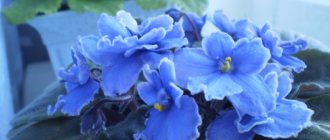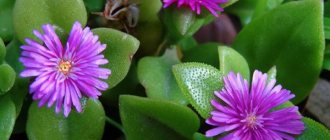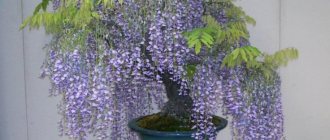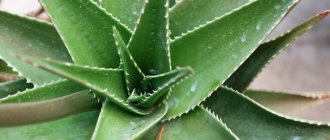Saintpaulia is a genus of beautiful flowering plants in the Gesneriaceae family. One of the most popular indoor flowers. There are a huge number of varieties of Saintpaulias, or, as they are called, “Usambara violets”. You can choose almost any variety with the desired size and color. Compact, bright plants that can bloom almost all year round. Let's take a closer look at what these indoor flowers are and how to care for them.
Do not confuse Saintpaulia with Viola. These are two different genera belonging to completely different families. Saintpaulia, also known as Usambara violet, belongs to the Gesneriaceae family and is a tropical plant. While the Violet, known to us under the common name “Pansy”, belongs to the Violet family and is grown as a garden plant.
Saintpaulia, or Usambara Violet © Burke County Center - NC State University
History of the discovery and spread of Saintpaulia
The Uzambara violet was discovered in 1892 by Baron Walter von Saint-Paul (1860-1940), commandant of the Uzambara district, a German colony located in the territory of modern Tanzania, Burundi and Rwanda. Walter Saint-Paul noticed this plant while walking. He sent the collected seeds to his father, the president of the German Dendrological Society, and he gave them to the botanist Hermann Wendland (1825-1903). Wendland grew the plant from seed and in 1893 described it as Saintpaulia ionanta, establishing the species as a separate genus, which he named after the Saint-Pauls father and son.
Saintpaulia was first presented at the international flower exhibition in Ghent in 1893. In 1927, Saintpaulias came to the United States, where they immediately gained popularity as indoor plants. By 1949, one hundred varieties had already been bred. Today the number of varieties exceeds 32 thousand, of which over 2 thousand are domestic.
Description of Saintpaulia
Saintpaulia is loved in indoor floriculture for its small size and long (up to 10 months a year) flowering. The flowerpot is usually a low herbaceous plant with fleshy, hairy, round leaves. Leaves of green or spotted color are located on shortened stems forming a basal rosette.
The flowers have five petals, collected in racemes. Color and shape depend on the variety. Saintpaulia also has a calyx consisting of five sepals. The fruit is a capsule with numerous small seeds with a straight embryo.
The natural range of Saintpaulia is limited to the mountainous regions of Tanzania and Kenya, with the vast majority of species found only in Tanzania, in the Ulugur and Usambara Mountains (usually the name "Usambara Mountains" on modern maps). Saintpaulias often grow near waterfalls, rivers, in conditions of spray and fog.
Uzambara violet: description
brief information
- Plant of the Gesneriaceae family (lat. Gesneriaceae);
- Botanical genus: Saintpaulia (lat. Saintpaulia);
- Scientific name: Saintpaulia ionantha;
- Other names: Usambara violet, African violet, Saintpaulia;
- Origin: Usambara Mountains, Tanzania;
- Possible year-round flowering;
- Growth height from 10 cm to 15 cm;
- Colors and shades of flowers: blue, purple, pink, red, white, multicolor;
- Bright golden yellow anthers in the center of the flower;
- An excellent source of indoor oxygen;
- The plant is sensitive to lime;
- pH value: slightly acidic to acidic.
Origin
Usambara violets (lat. Saintpaulia Ionantha hybrids) belong to the Gesneriaceae family (lat. Gesneriaceae). They are descended from the wild Usambara violet, which is native to the Usambara Mountains in Tanzania. Hybrids are slightly larger than the wild form. The plant is not a violet (lat. Viola). The name is associated with the purple color of the flowers of the first varieties.
Height
Uzambara violets grow compactly. Flat rhizomes form rosettes of leaves up to 20 cm in diameter, from which grows a short flower stem about 15 cm high. These are evergreen plants both in their tropical homeland and when grown as an indoor flower.
Leaves
A characteristic feature of the Uzambara violet is its velvety, fleshy leaves, which are very sensitive to wetting with water.
Flowers
The pleasure of blooming Usambara violets has made them a popular houseplant for decades. They are available with white, pink, red, blue or purple flowers that can be single, double, single or multi-coloured. The bright golden-yellow anthers in the center of the flower are always noticeable. Some specimens have smooth petals, others have wavy petals. Usambara violets also bloom during the winter months, providing a beautiful blooming spectacle all year round.
What to look for when buying Saintpaulia?
First of all, when buying Uzambara violet, you should pay attention to the leaves. If you find any suspicious spots on them or a too tight growth point, then this plant is probably affected by some kind of disease. Even for a specialist it will be difficult to grow and produce such a flower, and for a beginner it will be almost impossible. Therefore, it is better to choose a plant with bright green leaves, without signs of pest damage.
When choosing a baby, it is important that the leaves are not very elongated - this indicates that the plant has already suffered from a lack of light.
To propagate Saintpaulias, it is best to take a leaf cutting from the second bottom row. The lower leaves are also produced by children, but, as a rule, they are more emaciated due to their advanced age, so the offspring will certainly be weaker.
And be sure to ask the seller to indicate the varietal identity of the plant, so that you don’t have to worry about identifying the Saintpaulia variety later. Some collectors also indicate the planting date of the plant on the label with the variety.
To transport Saintpaulia leaf cuttings, it is convenient to use boxes, plastic containers or other containers that will prevent the cuttings from breaking when transported on public transport. If such a container is not at hand, then ask the seller to inflate a plastic bag and tie it tightly, in this case the cutting will not be injured during transportation. If the leaves do break, they need to be removed from the outlet.
Saintpaulia, or Usambara violet © Saintpaulia Jardineria On
When choosing pots for Uzambara violets, their size is important, namely the diameter. It should be 5-6 cm for children and young rosettes, for adult rosettes no more than 10-12 cm. Ideally, the diameter of the pot for an adult rosette should be 3 times smaller than the diameter of the rosette itself.
Both plastic and ceramic pots are suitable for Saintpaulias. Currently, collectors prefer to grow Uzambara violets in plastic pots, because... they are cheaper and more convenient.
Growing conditions and care for Saintpaulia
Growing Uzambara violets (Saintpaulias) requires some effort. If you want Saintpaulia to bloom profusely and for a long time, you must adhere to the following rules.
The temperature should be even, not too hot in summer and not too cold in winter. Optimum temperature +18..+24°C. Uzambara violets do not like sudden temperature fluctuations and drafts.
Uzambara violet prefers bright light , but does not like direct sunlight, therefore, if the plant is on a sunny windowsill, it must be shaded, and in winter it is desirable to have additional lighting with fluorescent lamps so that the violets have 13-14 hours of daylight. In this case, Saintpaulia will bloom in winter.
Saintpaulias need uniform watering . The surface layer of soil should be constantly moist, but the plant should not be flooded either. Water carefully, at the root. Excess water from the pan must be drained. Water for irrigation should not be cold and preferably soft, in any case, it must be settled. Uzambara violet, the leaves in particular, do not tolerate spraying. If drops of water get on the leaves, they can rot. To ensure sufficient air humidity, it is good to place the Saintpaulia pots on a tray with water, but so that the pot itself does not touch the water, or place wet moss on the tray. You can place the pots in damp peat.
The soil for Uzambara violets must also meet special requirements . It should be loose, allow air to pass through well and easily absorb water. You can buy a ready-made earthen mixture for Saintpaulia, or you can make it yourself from leaf and turf soil, humus, sand, charcoal, bone meal with the addition of superphosphate. The proportions are as follows: 2; 0.5; 1; 1. Add 0.5 cups of bone meal and 1 tablespoon of superphosphate to a bucket of prepared earthen mixture.
Rejuvenation of Saintpaulia, Violets:
Violets, like all plants, tend to age and after a while, in order to maintain the decorativeness and splendor of flowering, it simply needs to be renewed. If the lower leaves of the rosette of your Violet die off (the stem is more than 3 cm), it begins to fall to one side and flowering begins to occur less frequently and not as luxuriantly - this means it needs to be rejuvenated. Rejuvenation of the rosette occurs in two ways - deepening and re-rooting.
Deepening is carried out if the Violet is not that old (less than 3 years), but its decorative effect has been lost for various reasons. Burying is the easiest way. To do this, the bare area of the leg is cleared of the cork layer using the blunt side of a knife, then the leg must be wrapped in damp sphagnum moss and buried in a pot. If the height of the pot does not allow it to be deepened, the rosette must be removed from the pot and the lower substrate must be trimmed from the roots. If there are a lot of roots, you can tear off the lower roots a little. The buried rosette must be placed in a greenhouse for 1-2 weeks.
Re-rooting is mandatory for plants that have already undergone several burials, for rosettes more than 3 years old. To do this, the top of the rosette is cut off below the last row of leaves by 1 cm, and the cork layer must be cleaned. If there are too many leaves, the entire bottom row must be removed. All cut areas must be treated with activated carbon. For faster rooting, the rosette must be treated with root, wrapped with sphagnum moss and the substrate is planted. It is advisable to secure the socket with toothpicks. Rooting in such cases lasts about a month. Don’t be alarmed if the leaves of the rosette become limp; as soon as the plant’s first roots appear, all the leaves will return to their turgor. In greenhouse conditions, you should not water the substrate, but if you notice that the soil has begun to dry out, it should be lightly watered.
As soon as you notice the appearance of new growth, you can begin to wean the plant from the greenhouse. It is also permissible to root a cut rosette in water. This way you can control the appearance of roots. Don't forget to add activated carbon to the water. Don’t rush to throw away the pot with the remaining roots; after a while, Saintpaulia’s roots will produce babies.
Details about feeding Saintpaulia
In their homeland, Saintpaulias grow on fairly poor soils, so when preparing earthen mixtures, amateurs try not to give them too many nutrients. But since the root system of the plant is located in a small volume of substrate, over time the soil in the pots is gradually depleted. Therefore, you have to periodically feed the plants. True, you should not feed immediately after transplantation - for two months there will be enough food for Saintpaulia.
When feeding plants, we should not forget that an excess of nutrients can cause various undesirable phenomena. For example, excess nitrogen leads to rapid leaf growth to the detriment of flowering. “Overfed” plants become unstable to diseases and pests. With a significant excess of phosphorus, Saintpaulias age faster, buds fall off, and young leaves become deformed. If there is a lot of potassium, the plants stop growing and the leaves turn yellow.
The concentration of the nutrient solution for fertilizing depends on many factors, in particular the size of the pot and the composition of the soil mixture. Finally, it is taken into account that Saintpaulias are plants that cannot tolerate high salt content. Too concentrated solutions (more than 1.5-2 g of salts per 1 liter of water) are harmful to plants.
Saintpaulia, or Usambara violet © Tropical World Nursery
The smaller the size of the pot and the amount of soil in it, the weaker the concentration of salts should be (but you need to feed more often). Plants on loose soils can be fed more often than on heavy soils - in the first case, fertilizers are washed out faster.
When watering Saintpaulia with a highly concentrated solution, the roots of the plants are damaged and the leaves become soft. If urgent measures are not taken, the plant may die. In this case, you need to thoroughly pour the earthen lump with warm water (0.5-1 l.) in small portions. Then the pot is placed in a shaded place.
The optimal concentration of fertilizers for Saintpaulia can be considered 1 g of complex mineral salts, diluted in 1 liter. water. Each subsequent feeding in this case is carried out after 15-20 days. Feeding with weaker solutions (1 g per 3 liters of water) is also effective. Such solutions can be watered more often - every 5-6 days. Constant fertilizing with watering also deserves attention - in this case, 1 g of fertilizer is dissolved in 6-8 liters. water.
Saintpaulias should be fed only at the most favorable time of year for their growth. So, in the middle zone it is advisable to fertilize from March to September.
Transplanting Saintpaulia
In what pot and when should I transplant Saintpaulia?
It is advisable to replant mature Saintpaulias into fresh soil mixture every year. After all, their root system is located in a small volume of soil, which over time loses structure and nutritional value. They are usually replanted in the spring, but if they are growing in artificial light, this can be done at any time of the year.
The most common mistake when growing Saintpaulias is using pots that are too large. Let us remind you that pots are distinguished by numbers, which correspond to the diameter of the pot at the top. For young plants that have just been separated from the mother leaf, small pots (No. 5 or 6) are sufficient. In the future, when the plants grow up, they can be transplanted into containers No. 7 or 8. The maximum pot size for the largest adult specimens is No. 9 or 11. A container that is too spacious can often lead to rotting of the roots.
Before use, new clay pots should be soaked in hot water for 30-40 minutes, and then allowed to cool and dry. If this is not done, then after planting the walls of the pots will absorb too much water to the detriment of the plant. Sometimes you have to reuse containers whose edges are coated with salt. Therefore, they must be thoroughly washed with a hard sponge in hot water, and the deposits must be removed with a brush or a blunt knife.
Proper drainage during transplantation
When transplanting Saintpaulia, first of all, you should pay attention to drainage. The drainage layer, which is poured on top of the shard covering the bottom hole, serves to drain excess water from the lower layers of the earth. It promotes additional air access to the roots, prevents compaction of the lower part of the earthen ball, and is especially important when planting in plastic containers.
Typically, drainage takes up 1/5 of the pot's volume. The condition of the earthen mixture and its acidity largely depend on its quality. It is better to use crushed shards from clay pots as a drainage layer; they do not change the acidity of the substrate. You can use well-washed coarse sand (fraction size 1-2.5 mm). Small granules of expanded clay, a light brown building material, are also suitable; larger granules should be crushed. Expanded clay drainage needs to be changed every year, as over time compounds that are toxic to Saintpaulias accumulate in it.
The most commonly used synthetic materials are polystyrene (artificial resin) and polystyrene crumbs. The latter is crushed by hand into crumbs (5-12 mm). Granular polyethylene, a chemically inert, lightweight, durable synthetic material (grain size 3-5 mm), is more difficult to access.
Saintpaulia, or Usambara violet © Suttons Seeds
Plant materials: pine bark chips, nut shells, cork, crushed pine cones, etc. can be used for drainage, taking into account that they usually acidify the soil and do not always give a positive result. With such drainage, it is advisable to add small pieces of charcoal to the volume. Gravel and crushed granite usually contain particles that alkalize the substrate, so they can be used in acidic soils. Brick chips strongly alkalize the soil, so they are not recommended for drainage.
When planting Saintpaulia in small pots (5-7 cm), it is enough to cover the drainage hole with a clay shard. The rest of the volume is occupied by the earthen mixture. In larger containers (8-11 cm), a drainage layer (1.5-2 cm) is poured on top of the shard (which is placed with the concave side up) and several pieces of charcoal about 0.5 cm in size are placed on it (charcoal adsorbs harmful gases) .
Saintpaulia planting depth
The planting depth of Saintpaulia is of great importance. At the correct depth, the petioles of the lower leaves should be just above the surface of the ground or lightly touching it. If the planted plant is unstable, you can additionally place a layer of sphagnum moss about 1 cm thick on the surface of the ground. In this case, it may slightly cover the petioles of the lower leaves. Plants planted too high often turn out to be unstable, which slows down their growth and development.
When watering plants that are planted too deeply, soil particles fall into the center of the outlet, polluting it. Young leaves at the growth point are deformed, their development slows down. Often, in Saintpaulias that are too deep, the growing point rots, “rust” appears on the central young leaves, the leaves die, the stem rots, and the plant dies.
FAQ
Is it possible to display Uzambara violets on the balcony in summer?
This is strongly discouraged because Usambara violets are not suitable for balconies and terraces, despite their tropical origin. Although they love a bright and warm location, they cannot tolerate direct sunlight and sudden temperature changes.
Are Uzambara violets poisonous?
Usambara violets themselves are non-toxic to humans, but not entirely harmless. Because in dogs, cats, birds and small children, ingestion of these plants can lead to serious symptoms of poisoning. Therefore, Saintpaulias should be placed out of the reach of animals and small children.
If symptoms of poisoning appear, you should immediately consult a doctor or veterinarian, even if no bite marks are visible on Usambara violets.
Why doesn't the Uzambara violet bloom?
Usambara violets are considered perennial flowering plants. However, it happens that they take a break from flowering. In most cases, the reasons for lack of flowering are improper location, lack of fertilizer or draft.
Reason: Inappropriate location
Solution: Place the plant in the right place.
If Saintpaulia is repeatedly exposed to direct sunlight or constantly in the shade, it will not bloom. The same applies to exposure to low temperatures. Place the plant in a semi-shaded location with a constant temperature of 20 to 25 °C.
Reason: dry air
Solution: increase the humidity.
Usambara violet, which grows in tropical regions of the world, requires air humidity of more than 60%. This requirement is not always met, especially under the influence of dry heated air. Therefore, place bowls filled with water, a humidifier or a fountain in close proximity.
Cause: Substrate with high lime content
Solution: Repot the plant in acidic flower soil.
In the wild, the Uzambara violet grows in the tropical forests of Tanzania. The soil here is humus, loose and slightly acidic. For Saintpaulia to bloom, replant it in a suitable soil mixture. In addition, in the best case, the plant should be watered with collected rainwater or decalcified (settled) tap water so that lime does not accumulate in the substrate.
Propagation of Saintpaulia
Propagation of Uzambara violet from leaf cuttings
The most common method of propagating Saintpaulia is from leaf cuttings. To do this, you need a healthy, formed leaf (whether the mother plant blooms or not does not matter). The length of the petiole should be 3-4 cm, with an oblique cut. It is better to place the cuttings in water until roots form. If the cutting is immediately planted in the ground, then, firstly, the soil should be loose, not compacted, and secondly, the cutting is placed in the soil to a depth of 1.5 - 2 cm, no more. The pot with the cuttings is watered with warm water and covered with a plastic bag to maintain moisture; the temperature should not be lower than 20-21°C. The formation of roots and the development of children lasts 1-2 months.
Everyone can choose for themselves the most convenient, affordable and reliable method of rooting Saintpaulia cuttings. If this method is not chosen entirely successfully, then sometimes beginners experience disappointment when the cutting immediately rots and dies.
For home conditions, the most affordable way is to root the cuttings in boiled water. In cities where you can buy substrate components, many lovers of Uzambara violets root cuttings in agroperlite (coarse fraction) or vermiculite. Rooting in finely chopped sphagnum moss gives good results.
Many Saintpaulia lovers root cuttings in peat-humus tablets, in which the risk of leaf rotting is minimized.
The most general rule for all these methods is not to leave a long stalk. Babies will appear faster and larger if the length of the petiole does not exceed 4 centimeters. The cut should be made with a sharp razor or scalpel.
When rooting Saintpaulia cuttings, it is important to provide high air humidity and a temperature of +20..24°C. It is recommended to place rooting cuttings in a greenhouse or in a plastic bag.
Babies appear, on average, after 4-6 weeks. When they get stronger and grow, they will need to be carefully separated from the leaf, trying to minimally injure the roots of the baby. Then you should put the baby in a separate pot. The diameter of the baby pot should not exceed 6 cm. The leaf (if it is strong) can be re-rooted.
When planting a child, it is necessary to put drainage (sphagnum moss, pieces of polystyrene foam or small expanded clay) at the bottom of the pot. The soil for children should be loose and nutritious; 1/5 of vermiculite and 1/5 of perlite can be added to the substrate. If there is sphagnum moss, then it should also be added to the substrate, first finely chopped with scissors, at the rate of 1/5 of the total volume of the mixture.
The planted Saintpaulia children need to be placed in a mini-greenhouse so that the children adapt there in 2-3 weeks. Place the greenhouse with the babies on a light windowsill (preferably not on the southern one, where Uzambara violets need to be shaded to avoid burns on the leaves). In winter, make sure there is no blowing from the window, as Saintpaulias are very sensitive to hypothermia of the root system. Grown-up children can be gradually accustomed to room conditions by ventilating the greenhouse with the children for 10-15 minutes, then 30 minutes.
Propagation of Saintpaulia © Wikimedia Commons
Reproduction of Saintpaulia by stepsons
To propagate Uzambara violet, you can use not only leaf cuttings, but also stepsons. For successful rooting, the stepson must have 3-4 leaves. To separate the stepson from the socket you need to have an awl or a sharp scalpel. When removing the stepson, you need to try not to injure the leaf cuttings of the main rosette.
To root the stepson of Saintpaulia, you can use a peat humus tablet or a pot of substrate. For better adaptation and faster rooting, the planted stepson should be kept in a greenhouse for 3-4 weeks.
Propagating violets at home: 2 ways
Basically, Saintpaulias are propagated with leaves, segments from plates, and rosettes . And although this can be done all year round, experts say that it is still better to propagate the plant in spring or summer. This is due to the fact that during this period there is more heat and light - necessary factors for the rapid rooting of planting material.
Leaf
Leaf propagation is the simplest method. Cut the plate under the peduncle from a completely healthy plant. The cut needs to be dried for about half an hour. Fill a small dark glass jar (you can use a pharmacy bottle) with cool boiled water and activated carbon powder.
Cover the top with film, cut a hole and stick a leaf into it. When the roots appear, move them into the soil. A greenhouse can be easily made from a plastic bottle. The babies will arrive in a couple of weeks. You need to wait until the leaves reach 1 cm in diameter and plant them in pots.
By division
In pots of violets, several leaf rosettes are often formed at once . They are separated with a well sharp knife. At least a small spine remains on each part. The delenki are immediately planted in the ground.
This video shows the transplantation of Uzambara violet (Saintpaulia) babies.
Saintpaulia diseases
Infectious diseases
The causative agents of infectious plant diseases can be bacteria, fungi, viruses, which contribute to their very rapid spread.
Gray rot
An infectious fungal disease known as gray mold is caused by the Fusarium fungus. Flowers and buds become covered with gray mold, and the affected areas die off. Typically, the fungus infects the plant by landing on dried, diseased flowers and damaged leaves. The disease develops intensively at low air temperatures (below 16°C), abundant watering, high humidity, excessive nitrogen fertilization, and poor air circulation.
To prevent infectious decay, you must strictly observe the regimes of watering, temperature, and humidity. If mold is detected, the affected parts are removed, the plant is treated with a solution of disubstituted sodium phosphate (1 g per 1 liter of water) or other fungicides (benlate, etc.).
Powdery mildew
Powdery mildew is a fungal disease that appears as a whitish coating on the flowers, peduncles and leaves of Saintpaulia. At the same time, it seems as if they are sprinkled with flour.
The spread of powdery mildew is facilitated by dust and dirt on plants, window sills and shelves where they are placed. It is very important to maintain cleanliness. Pots and trays must be washed periodically with warm water.
The occurrence of the disease is also facilitated by insufficient lighting (in the back of the room), short daylight hours (7-8 hours per day) or high air humidity at low temperatures (14-16°C).
The disease is more pronounced if the soil mixture contains too much nitrogen, but not enough potassium and phosphorus.
Excess nitrogen in the soil mixture can be determined by the appearance of the plants, in particular, by the condition of young leaves at the growth point. With normal development of Saintpaulia, young leaves increase evenly and develop well. Due to excess nitrogen, these leaves become compacted and deformed, pushing against the next row of leaves. Subsequently, the deformed young leaves are freed from crowding. The plant grows, the leaves increase excessively in size, become hard and brittle. Saintpaulia blooms weaker, the flowers are smaller than usual, side shoots (stepchildren) appear.
To get rid of powdery mildew, it is necessary to mainly use fungicides. Sometimes you need to take care to reduce the nitrogen content. To do this, the earthen lump is spilled with warm water (30°C) - approximately 0.3 liters per pot. Subsequently, it is fed with phosphorus and potassium fertilizers (1 g per 1 liter of water).
Of the fungicides, those that, after treatment, do not damage the delicate pubescent leaves of Saintpaulia and do not leave stains are used. An aqueous solution of benlate (fundozol, 1 g per 1 liter of water) is effective, which is used to treat plant leaves and moisten the earthen ball. Usually one spray is sufficient, but if the desired results are not achieved, it is repeated after 10 days.
Fundozol also relieves plants from some other fungal diseases. It does not affect the leaves of Saintpaulia, but sometimes leaves subtle spots, which are subsequently removed with water.
The commercially available fungicide - disubstituted sodium phosphate (a means of combating powdery mildew of fruit, berry and ornamental crops) is convenient in that it simultaneously acts as a phosphorus fertilizer. After treatment with this preparation, the leaves are not damaged, but burn spots are possible on the blossoming flowers. Half-opened flowers and buds develop normally.
When using disubstituted sodium phosphate, the concentration of the aqueous solution must not be exceeded. To treat leaves, take 1 g of the drug per 1.5 liters of water, and for watering plants - 1 g per 1 liter of water. Usually one treatment is enough; in extreme cases, it can be repeated after 10-12 days. It is not recommended to process Saintpaulia more than twice. This drug also destroys mold on the surface of the earth.
After spraying violets with fungicides, the most affected flowers and pedicels should be removed. Aqueous solutions for treatment should be lukewarm. To avoid light burn of the leaves after washing, they are allowed to dry in a shaded place.
Saintpaulia, or Usambara violet © gesneriadsociety.org
Non-communicable diseases
Non-communicable diseases usually arise due to poor agricultural practices. They may appear on one instance and not be transmitted to others.
Rotting of the stem and root system
Rotting of the stem and root system of Saintpaulia. The first sign of stem rotting is the wilting of the lower leaves. They become dull, as if dusty, as if the plant needs watering (although the earthen ball is quite moist). Rotting of the roots and stem can be noticed during transplantation. The reasons may be planting in dense, heavy soil, a high concentration of fertilizers in the soil mixture, large pots, watering with cold water, insufficient air temperature (below 20°C), or planting plants too deep.
In adult Saintpaulia specimens, the stems also rot when the soil is compacted and there is no free access of air to the roots. In this case, the part of the stem located in the ground rots, the roots grow only in the upper layer of the earthen ball (the earthen ball is very dense inside), the rosettes of leaves lose their decorativeness and stability in the soil. It is best to transplant them into fresh soil mixture. If this is not done, the stem rots and the plant dies.
Wilting and rotting of the lower leaves
In a healthy plant under normal conditions, the lower row of leaves functions well, as a rule, for about a year. Then comes their natural death. Saintpaulia leaves change color, yellowed areas appear with signs of rotting or drying out of the edges. As they age, such leaves are removed by breaking them off at the base of the stem.
The petioles of the lower healthy leaves are often damaged in places of contact with the edges of the clay container, especially if they are uneven. To avoid this, the edges of clay pots are first coated with several layers of varnish or a melted mixture of natural wax (0.2 parts), rosin (1 part) and sealing wax (2 parts). The mixture should not be overheated (brought to a boil) - this will cause bubbles to appear on the edges of the pots, which is undesirable. When processing, the inverted pot is immersed in the molten mixture by 0.5-1 cm and immediately lowered into cold water.
You can process the edges of the pots in this way by dipping them into melted sealing wax mixed with 1/8 of the wax or into pure wax. Melted paraffin gives worse results, as it cracks, pieces fly off, and mold and algae can develop in this place.
Some gardeners do things differently. They take a thin rubber tube, cut it lengthwise and then, cutting a piece equal to the circumference of the pot, put it on the edge, thus protecting the petioles of the leaves. Sometimes amateurs install special supports for leaves from thick wire so that they do not lie on the edges of the pot, but this does not look very elegant.
During planting, the petioles of the lower leaves of Saintpaulias are often injured. Subsequently, such leaves begin to rot at the stem. They must be removed and the stem at the break point sprinkled with charcoal powder.
Yellowing of Saintpaulia leaves
The reasons are excessive illumination when direct sunlight falls on the plant, or weak shading, as well as a constant lack of moisture or nutrients in the soil. If there is a lack of nutrients in the soil mixture, fertilizing (not too strong concentration) is recommended. If even after this no positive results are visible, then the acidity of the soil mixture should be checked. Soil that is too acidic (pH below 4) or alkaline (pH above 7) should be replaced.
Saintpaulia leaf spot
Stripes, rounded spots of irregular shape, white, yellowish or brownish in color appear on the upper side of the leaves. Most often, this is the result of exposure to direct sunlight (especially if it hits wet leaves after watering), washing with cold water or spraying. Such spots can also appear in winter, when a flow of cold air is directed at the plants during ventilation. If the spots do not go away in the future, you have to wait until new green leaves develop. To avoid stains, you need to maintain a constant, fairly high air temperature, shade plants from direct sunlight, and do not place plants with wet leaves on the windowsill.
Translucent spots on Saintpaulia leaves
Such spots are clearly visible in the light. They appear from constant heavy watering, especially if the soil is prone to acidification (for example, it contains a lot of incompletely decomposed leaves). In this case, you can spill the earthen ball with a weak solution of potassium permanganate (pink), adjust the watering regime or change the earthen mixture.
Saintpaulia, or Usambara violet © Alaska in Pictures
Incomplete opening and premature drying of Saintpaulia flowers
This is facilitated by greater dryness and increased air temperature (such conditions often occur in winter, with central heating), short daylight hours (less than 9 hours a day), and too acidic soil (pH below 4.5). Overly fertilized soil containing excess nitrogen also has a negative effect.
Falling flowers and buds of Saintpaulia
The main reason is a sharp change in external conditions. For example, Saintpaulia grew and bloomed in a room with high air humidity (in a greenhouse), but then was moved to a room where the air humidity is much lower. Either Saintpaulia was moved from a cool place to where the temperature is much higher, or when airing in winter, a stream of cold air hit the plant. Watering plants with a highly concentrated fertilizer solution also leads to the falling of flowers and buds.
Saintpaulia or Violet. Growing problems:
- The appearance of light yellow spots, yellow edges and holes on the foliage indicates a lot of direct sunlight.
- The leaves bend down towards the pot, the color of the leaves is too pale, almost yellow, the petioles of the leaves are shortened, the young leaves are deformed, the flower stalks are shortened, the flowering becomes smaller and turns pale when there is too much light.
- When there is insufficient light, the leaf petioles lengthen and the leaves begin to stretch upward.
- Pale color of the leaves and curling of the edges of the leaves indicate exposure to cold.
- Yellowing of leaves occurs most often when the air is dry, but the reason may also lie in excessively abundant sunlight or improper watering and fertilization.
- In the variegated variety, the variegation disappears, there is no flowering and no growth in low light.
- Brown spots on the foliage indicate watering with cold water.
- Droopy foliage due to excessive watering or waterlogging of the soil.
- The plant does not bloom most often in insufficient light, especially in winter.
- Also, lack of flowering occurs due to low temperature and humidity, or too frequent replanting.
Views: 1,156











